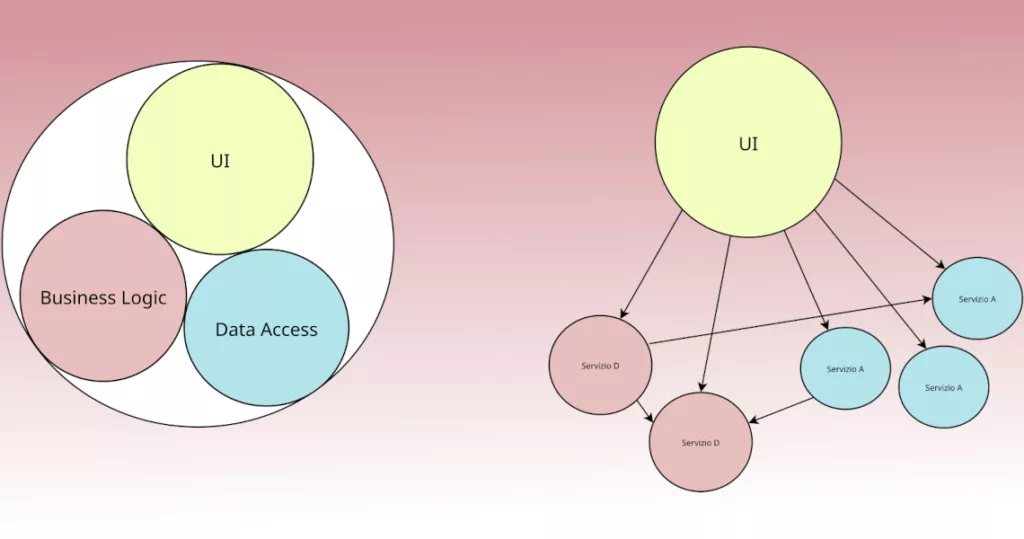When it comes to designing and implementing software applications, the choice between several possible architectural schemes should always be well thought out. Two of the most popular and widespread schemes are monolithic architecture and microservice architecture.
A monolithic application is a single application that includes within it everything (or almost everything) necessary for its proper execution, while a microservice architecture is composed of smaller, independent services.
Which one to choose between the two depends on various factors. Let’s look at them together.

What is a monolithic architecture?
A monolithic architecture represents the traditional model of software development, conceived as a unified entity that is self-contained and independent of other applications. The definition of “monolith” suggests an image of something massive and immobile, which is not too far from the reality of a monolithic architecture in the context of software design.
In a monolithic architecture, the application is deployed as a single, large codebase that contains all the functionality, including the data access and presentation interface needed to run the application.
To make changes to such an application, it is necessary to act on the entire application by operating on the sources, reassembling the code and deploying an updated version. This process makes updates extremely delicate and requires considerable resources in terms of time and effort needed.
On the other hand, the use of monoliths can be convenient in the early stages of a project, as it simplifies the management of the code base, reduces architectural complexity and overall simplifies the first release. This is as a result of the fact that all the parts that make up the application can be developed at the same time and that being assembled in a single package greatly simplifies installation.
In choosing a monolithic architecture over one based on microservices, the main advantage lies in the speed of development, which comes from the simplicity of managing an application with a single code base.
Advantages of a monolithic architecture
Advantages of a monolithic architecture include:
- Ease of deployment – Having a single executable file or compressed archive facilitates deployment.
- Development – When an application is built with a single code base, it is easier to develop.
- Performance – In a centralized code base and repository, a single API can often perform the same function that numerous APIs perform with microservices.
- Simplified testing – Because a monolithic application is a single centralized unit, end-to-end testing can be performed more quickly than in a distributed application.
- Ease of debugging – With all the code located in one place, it is easier to follow an application and find a problem.
Disadvantages of a monolithic architecture
Monolithic applications can be very effective until they become too large and scalability becomes a challenge. Making a small change to a single feature requires compiling and testing the entire platform, which goes against the agile approach preferred by today’s developers.
Disadvantages of a monolith include
- Reduced development speed – A large monolithic application makes development more complex and slower.
- Scalability– Individual components cannot be scaled.
- Reliability – An error in one module can compromise the availability of the entire application.
- Barrier to technology adoption – Any change in the framework or language impacts the entire application, making changes often costly and time-consuming.
- Lack of flexibility – A monolith is constrained by the technologies already used in the monolith.
- Deployment – A small change to a monolithic application requires deployment of the entire monolith.
What are microservices?
A microservices-based architecture represents an architectural approach that is based on the autonomous deployment of a set of services. Each service has its own business logic and database, all targeting a specific purpose. Aspects such as updating, testing, deployment and scalability are managed internally within each service. Microservices break down major complexities and domain-specific details into several independent code bases. Instead of reducing complexity, microservices highlight it, making it clearer and more manageable by separating activities into smaller processes that operate independently, each contributing to the overall result.
Advantages of microservices
Microservices are by no means a silver bullet, but they solve a number of problems for growing software and businesses. Because a microservice architecture consists of units that operate independently, each service can be developed, updated, deployed, and scaled without affecting other services. Software updates can be performed more frequently, improving reliability, uptime, and performance.
More generally, microservices make it easier for teams to update code and speed up release cycles with continuous integration and continuous delivery (CI/CD). Teams can experiment with code and go back if something goes wrong.
In short, the advantages of microservices are:
- Agility – They promote agile ways of working with small teams that deploy frequently.
- Flexible scalability – If a microservice reaches its capacity, new instances of that service can be quickly deployed to the companion cluster to help relieve pressure. We are now multi-tenant and stateless, with clients distributed across multiple instances. We can now support much larger instances.
- Continuous deployment – We now have frequent and faster release cycles. We used to release updates once a week, now we can do it two or three times a day.
- High maintainability and testability – Teams can experiment with new features and go back if something doesn’t work. This makes it easier to update the code and accelerates the time-to-market of new features. In addition, it is easy to isolate and fix errors and bugs in individual services.
- Independently deployable – Because microservices are individual units, they enable quick and easy independent deployment of individual features.
- Technology flexibility – Microservice architectures allow teams to freely choose the tools they want.
- High Reliability – Changes can be deployed for a specific service, without risking crashing the entire application.
Disadvantages of microservices
As you move from a limited number of monolithic codebases to an increasing number of distributed systems and services that support your products, unexpected complexity emerges. Initially, it is difficult to add new functionality with the same efficiency and security as in the past. Adoption of microservices can lead to additional complexity that can result in the scattering of development efforts or fast, uncontrolled growth. Clearly identifying how various components interact with each other, who is responsible for a particular software component, and how to avoid interference with dependent components can present complex challenges.
Disadvantages of microservices may include:
- Diffuse development – Microservices add more complexity than a monolith architecture because there are multiple services at multiple points created by multiple teams. If development sprawl is not properly managed, development speed slows and operational performance is poor.
- Exponential infrastructure costs – Each new microservice can have its own cost for test suites, deployment playbooks, hosting infrastructure, monitoring tools and more.
- Additional organizational costs – Teams must add an extra layer of communication and collaboration to coordinate updates and interfaces.
- Debugging issues – Each microservice has its own set of logs, which makes debugging more complicated. In addition, a single business process may run on multiple machines, further complicating debugging.
- Lack of standardization – Without a common platform, there can be a proliferation of languages, logging and monitoring standards.
- Lack of clear ownership – As more services are introduced, the number of teams managing them also increases. Over time, it becomes difficult to know what services are available that a team can leverage and who to contact for support.

